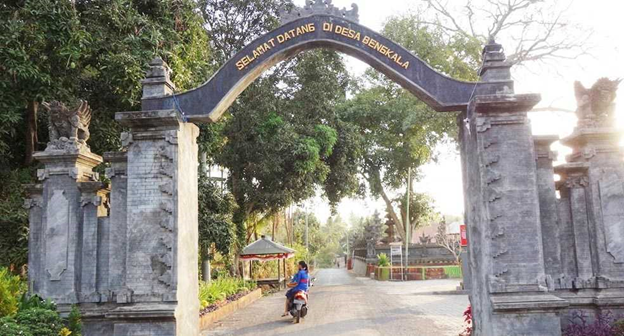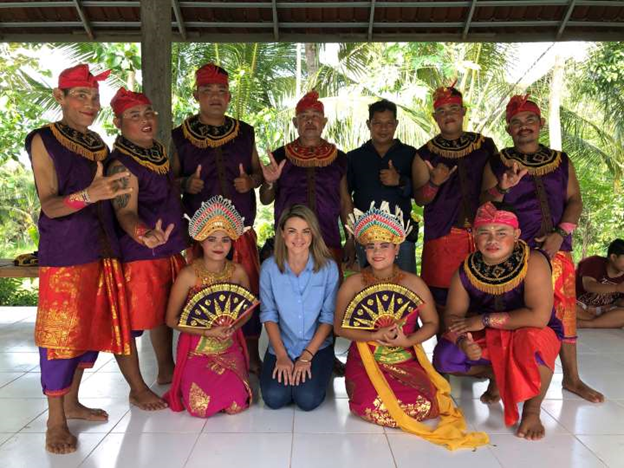Bengkala Village Profile
Those who visit Bali tend to rely on English, which many locals can
speak. Fewer visitors have mastered Indonesian, the official language. Balinese
is hardly spoken among those who aren't natives. But up in the jungle of
northern Bali, there's an even more elusive, geographically-consolidated
language, foreign to even the native Balinese, kata kolok, a language that's
never even been spoken.
Kata kolok, known as "the talk of the deaf,"
is a unique, rural sign language, independent of international or Indonesian
sign language. It's been the primary mode of communication in the northern Bali
jungle village of Bengkala for generations, where a high percentage of
residents are deaf. In Balinese, Bengkala
is sometimes called "Desa Kolok"— the deaf village.
Bengkala is a village located in the Kubutambah subdistrict, Buleleng Regency, Bali Province, Indonesia. This village has an average height of 250 meters above sea level. This village is known to have dozens of deaf residents, who in Balinese are called kolok.

Bengkala has had a higher than normal deaf-since-birth
population for over seven generations. Today, 42 of Bengkala's almost-3,000
villagers have been deaf since birth. By comparison, about two or three births
per 1,000 in the United States produce a deaf or hard of hearing child. The
high percentage of deafness is caused by a geographically-centric recessive
gene, called DFNB3, which has been present in the village for over seven
generations. For years, villagers believed the deafness was the result of a
curse.
"The famous story is that two people with magic
powers fought each other and then cursed each other to be deaf," said Ida
Mardana, the mayor of Bengkala village, who speaks Balinese, Indonesian, and
English, in addition to signing kata kolok. "The meaning of Bengkala is 'a
place for someone to hide.'"
The village of
Bengkala Buleleng is a unique village that must be visited. Bengkala Village is
a village with uniqueness that cannot be found in other areas of Bali Island.
Bengkala Village is a silent village that makes you learn many things from a
limited ability to speak.
Bengkala is an extraordinary village known for having
one of the highest deaf-and-mute-since-birth ratios in the world. The
traditional myth explaining this goes as such—A long time ago, the righteous
people of Bengkala stood up against their corrupt King. They firmly set their
own boundaries and refused to listen to, or even discuss the King’s
unreasonable commands any further. Because of this, the evil King cursed the
village to forever be deaf and mute as they were to his demands. The scientific
explanation, on the contrary, is a lot less exciting – the culprit is a
geographically-centric recessive gene that causes deaf-muteness at birth.
Despite its unconventional demographics, Bengkala’s most striking feature is not its deafness. Instead, it is its sense of community. Despite the deaf-mute population being an overwhelming minority in the village, the villagers have created their own village sign language in order to accommodate them by conveying ideas using natural movements. This is known as “Kata Kolok”, which translates into “the talk of the deaf”. As a testament to the inclusivity of this community, “Kata Kolok” has been adopted by more than fifty percent of the non-deaf population, and is commonly taught to children as a second or third language in school. The “Koloks” are not ostracised or discriminated against, but instead accepted as they are and integrated into the village. There is also an active community center for deaf residents.
Kolok and Enget
If deaf people are referred to as “Kolok”, those who
can hear are called "Enget" in the village. If you visit Bengkala,
anyone will easily find Kolok and Enget communicating in sign language. They
did not make a sound, but once in a while both of them would laugh out loud
because of the conversation that was done.
Enget really
appreciates the Kolok, they also help the struggles of the Kolok to survive and
live a normal life like normal society in general. Most deaf people in Bengkala
work as farmers or ordinary workers, like women who weave a lot of traditional
clothing. Others are employed to carry out security or funeral services.
In short, it is not difficult for Kolok to get a job in his own village, even though his income is not much. He also believes that Bengkala is the best place to live and develop for those who are deaf. In addition to many friends in the same boat and normal people who want to learn sign language, deaf people can also find work in the village.
Janger Kolok
The most empowering initiative to date has been the
introduction and development of janger kolok, or "the
dance of the deaf." The specific style of dance, created with Bengkala's
deaf population in mind, and has been the pride of Bengkala and the village's
most creative outlet for three decades.
The Deaf Dancers of Bengkala take the stage roughly
three times a month. The group is made up of 16 deaf villagers, ages 16 to 72,
who perform synchronized dance routines. While some performances take place in
the village and at a local university, their highest profile performances are
held at Bali Krishna, a modern exhibition hall in northern Bali. Sandi, the
group leader, hopes they will one day become "the number one dance group
in all of Indonesia."

The magic, of course, is in the synchronization.
Without music, it's difficult to keep rhythm, and yet the Deaf Dancers of
Bengkala step perfectly in time with each other, using visual cues to keep the
beat.
All profits from janger kolok in Bengkala go to the dancers, which Mardana hopes will help create a more consistent performance schedule and boost tourism to Bengkala. The village wants to increase the income of the deaf population, but they also want to increase tourism to the village, to expose others to the "oneness" between deaf and hearing people in Bengkala.
Source:
SIGN LANGUAGE-BASED EDUCATION THROUGH AUGMENTED REALITY